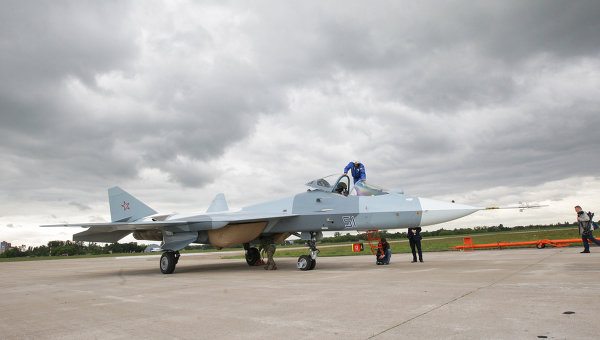In 2016, the Russian military will start deploying two advanced weapons, the fifth-generation fighter jet PAK FA and the long-range surface-to-air missile systems S-500, chief of the Russian Air Forces said.
Lieutenant General Viktor Bondarev gave an outline of his branch’s modernization plans, including the build-up of Arctic infrastructure, in a radio interview with the Russian News Service station on Sunday.
The flight trials of PAK FA (T-50) will soon be over, and in 2016 the Air Force is planning to start commissioning the aircraft into service, the general said.
PAK FA is Russia’s first fifth-generation fighter jet built by the Sukhoi Corporation. So far five prototypes have been completed and are undergoing various tests. The fighter is scheduled to eventually replace Sukhoi Su-27s.
“It took part in the [international pilot competition] Aviadarts twice and performed aerobatic flights in pair. I believe the aircraft has a brilliant future,” the general said.
Another new addition to the ranks planned for 2016 is S-500, a state-of-the-art long-range air defense system developed by Almaz Antei, Bondarev said. The producer is finalizing new missiles for the system, which would have advanced homing electronics.
“The missiles will have a build-in intelligence system, which will analyze the aerial and radar environment and take decisions about its altitude, speed and direction of the flight,” the general said.
S-500 is an advanced version of S-400 with dedicated components designed to intercept ballistic missiles at a height of up to 200 km. The system is expected to be able to shut down up to 10 incoming ballistic missiles simultaneously. It also has an extended radar range compared to S-400.
Gen. Bondarev confirmed the previously reported schedule for the development of PAK DA, a new Russian strategic bomber. So far little has been made public about the aircraft, which is to replace Tupolev Tu-95s and Tu-160s as the backbone of Russia’s aerial nuclear capability. It’s rumored to be a sub-sonic flying wing design and may have a new nuclear-capable cruise missile developed for armament.
The general confirmed that the Air Forces expect Tupolev to produce first prototypes of PAK DA by the end of the decade and launch series production in 2021-2022. In the meantime, modernization programs for Tu-95s and Tu-160s are enough to keep the Russian strategic bomber fleet in good shape and sufficient for the renewed long-range flight missions, he said.
Arguably the biggest modernization effort required from the Air Forces is focused on the Arctic infrastructure. Back in Soviet times the military maintained a massive network of airfields and radar stations in the north, but they were neglected in the years following the USSR’s collapse. With rich Arctic resources becoming more accessible and a potential for a conflict in the area growing, the Russian military are rebuilding the Arctic bases.
“We don’t see any rivals in the Arctic now, but if a challenge comes, we must be prepared to defend this region. The presence in the Arctic will be increased,” General Bondarev said.
Russia this year reopened the Temp airfield on Kotelny Island north of eastern Siberia, the general announced. There are plans to enlarge the bases in Tiksi, Alykel, Vorkuta and Anadyr. In the future, full-strength divisions and regiments of the Russian Air Force will be deployed in the north.









